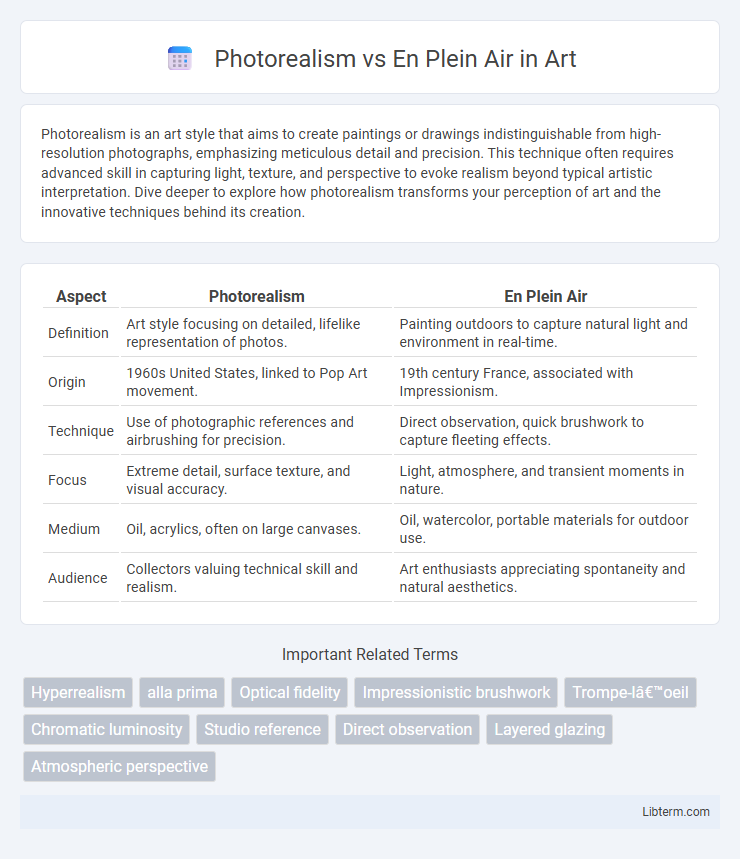Photorealism is an art style that aims to create paintings or drawings indistinguishable from high-resolution photographs, emphasizing meticulous detail and precision. This technique often requires advanced skill in capturing light, texture, and perspective to evoke realism beyond typical artistic interpretation. Dive deeper to explore how photorealism transforms your perception of art and the innovative techniques behind its creation.
Table of Comparison
| Aspect | Photorealism | En Plein Air |
|---|---|---|
| Definition | Art style focusing on detailed, lifelike representation of photos. | Painting outdoors to capture natural light and environment in real-time. |
| Origin | 1960s United States, linked to Pop Art movement. | 19th century France, associated with Impressionism. |
| Technique | Use of photographic references and airbrushing for precision. | Direct observation, quick brushwork to capture fleeting effects. |
| Focus | Extreme detail, surface texture, and visual accuracy. | Light, atmosphere, and transient moments in nature. |
| Medium | Oil, acrylics, often on large canvases. | Oil, watercolor, portable materials for outdoor use. |
| Audience | Collectors valuing technical skill and realism. | Art enthusiasts appreciating spontaneity and natural aesthetics. |
Understanding Photorealism: Definition and Origins
Photorealism, an art movement emerging in the late 1960s, is defined by its meticulous technique that replicates photographs with precise detail and clarity. Rooted in reactions to abstract expressionism, Photorealism emphasizes realism through airbrushing, layering, and photographic references to achieve an almost mechanical precision. Understanding its origins highlights artists like Chuck Close and Richard Estes, who pioneered this style by blending photography and painting to challenge perceptions of reality.
Exploring En Plein Air: History and Evolution
En Plein Air painting originated in the 19th century, popularized by the Impressionists who embraced capturing natural light and atmosphere directly outdoors. This technique evolved from traditional studio work, emphasizing spontaneity and immediacy in depicting landscapes with vibrant, shifting colors. Today, En Plein Air continues to inspire artists seeking authentic representation of nature's transient moments, contrasting with the meticulously detailed precision of Photorealism.
Key Techniques in Photorealism
Photorealism relies on techniques such as meticulous layering, precise color matching, and extensive use of photographic references to capture intricate details and textures. Artists employ airbrushing and fine brushwork to achieve smooth gradients and eliminate visible brushstrokes, enhancing the illusion of reality. This method contrasts with En Plein Air's spontaneous brushwork and focus on natural lighting, emphasizing exact replication over impressionistic interpretation.
Essential Methods in En Plein Air Painting
En Plein Air painting emphasizes capturing natural light and atmosphere by working outdoors, requiring quick brushwork and an understanding of shifting environmental conditions. Artists use portable easels, limited palettes, and fast-drying mediums to efficiently translate the scene's true colors and transient shadows. Mastery of color mixing, observation skills, and adaptability are essential methods for creating authentic, dynamic landscapes in En Plein Air practice.
Photorealism vs En Plein Air: Materials and Tools
Photorealism relies on smooth canvases, fine brushes, and airbrushes to achieve precise detail and clarity, often using photographs as references to capture realistic textures and lighting. En Plein Air painting demands portable, durable materials like oil or acrylic paints, sturdy easels, and canvases suited for outdoor conditions, emphasizing quick drying and versatility to adapt to changing natural light. While Photorealism focuses on meticulous studio techniques with controlled lighting, En Plein Air prioritizes spontaneity and responsiveness to the environment using practical, weather-resistant tools.
Artistic Intent: Capturing Reality or Expression
Photorealism prioritizes meticulous detail and precision to capture reality with photographic accuracy, emphasizing technical skill and replicative fidelity. En Plein Air focuses on expression and the emotional experience of the moment, often highlighting natural light and atmospheric effects to convey the artist's personal interpretation of a scene. Artistic intent in Photorealism centers on objective depiction, while En Plein Air embraces subjective expression and spontaneity.
The Role of Light and Atmosphere
Photorealism emphasizes precise light reflection and detailed atmospherics to create lifelike images with sharp clarity and fine surface textures. En Plein Air painting captures the transient effects of natural light and atmospheric conditions in real time, highlighting variations in color temperature and shadows that shift throughout the day. The role of light and atmosphere defines Photorealism's controlled precision versus En Plein Air's dynamic, immediate interpretation of the environment.
Challenges Faced by Photorealist and Plein Air Artists
Photorealist artists face challenges such as replicating intricate details and textures with extreme precision, often requiring extensive time and photographic reference materials. Plein air painters confront unpredictable weather conditions and changing natural light, demanding quick decision-making and adaptability to capture the scene's essence. Both styles require mastery of observation and technique but differ significantly in execution pace and environmental constraints.
Audience Perception and Cultural Impact
Photorealism captivates audiences with its meticulous detail and technical precision, often evoking admiration for artistic skill and contemporary culture's fascination with hyperreal imagery. En Plein Air painting resonates with viewers through its dynamic portrayal of natural light and environment, fostering a deeper cultural connection to nature and the moment of creation. The audience perceives Photorealism as a celebration of modern technology and visual accuracy, while En Plein Air emphasizes immediacy, sensory experience, and traditional artistic values.
Choosing Your Path: Which Style Suits You?
Photorealism demands meticulous attention to detail and a controlled studio environment, ideal for artists who prefer precision and fine rendering of subjects with high realism. En plein air, involving painting outdoors, suits those who thrive on capturing natural light, fleeting moments, and dynamic landscapes with loose brushwork and spontaneity. Assess your artistic goals, preferred workflow, and the environment you feel most inspired by to choose between the immersive, detail-oriented photorealist approach or the immediate, expressive style of en plein air painting.
Photorealism Infographic

 libterm.com
libterm.com